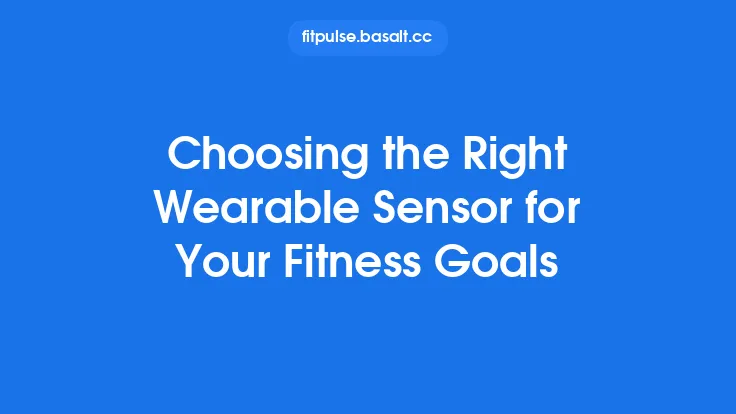Wearable fitness sensors have already become a staple in gyms, on running trails, and even in everyday life. Yet the technology is still in its infancy, and a wave of innovations is poised to transform how we train, recover, and understand our bodies. The coming years will bring sensors that are more precise, more integrated, and more intelligent than anything available today. Below is a deep dive into the most compelling trends that will shape the next generation of wearable fitness technology.
Emerging Sensor Modalities Beyond Motion
While accelerometers and gyroscopes have dominated activity tracking, future devices will incorporate a broader palette of sensing technologies:
- Optical Spectroscopy – Mini‑spectrometers embedded in wristbands can analyze skin reflectance to estimate blood oxygen saturation, hydration levels, and even muscle glycogen stores. By measuring specific wavelengths, these sensors provide biochemical insights that were previously limited to laboratory equipment.
- Electrochemical Sensors – Thin-film electrodes can detect metabolites such as lactate, glucose, and cortisol directly from sweat. Advances in microfluidic channels and selective membranes enable continuous, non‑invasive monitoring of metabolic stress during prolonged exercise.
- Acoustic and Vibration Sensors – Piezoelectric elements can capture subtle vibrations generated by muscle contractions, offering a new avenue for estimating force output and muscle fatigue without the need for external force plates.
- Magneto‑inertial Sensors – Combining magnetic field detection with inertial measurement expands the ability to track complex three‑dimensional movements, such as those in gymnastics or martial arts, with higher fidelity.
These modalities will converge in multi‑sensor platforms, allowing a single device to deliver a holistic picture of performance, physiology, and recovery.
Flexible Electronics and Stretchable Substrates
Traditional rigid PCBs limit how closely a sensor can conform to the body. Emerging materials science is breaking that barrier:
- Organic Conductors – Conductive polymers such as PEDOT:PSS can be printed onto fabrics, creating circuits that stretch and bend with the skin. This reduces motion artifacts and improves signal quality during high‑intensity activities.
- Nanomaterial Inks – Silver nanowire and graphene inks enable ultra‑thin, transparent electrodes that can be integrated into smart clothing or even directly onto the epidermis as temporary tattoos.
- Self‑Healing Polymers – Materials that can repair micro‑cracks after mechanical stress extend device lifespan and maintain sensor accuracy over months of rigorous use.
These flexible platforms not only enhance comfort but also open the door to embedding sensors in unconventional locations—such as the forearm, torso, or even footwear—where they can capture data that wrist‑worn devices miss.
Energy Harvesting and Autonomous Power
Battery capacity will remain a limiting factor, but the next wave of wearables will increasingly rely on self‑sustaining power sources:
- Thermoelectric Generators (TEGs) – By exploiting the temperature gradient between skin and ambient air, TEGs can generate milliwatts of power sufficient for low‑energy sensors and intermittent data transmission.
- Piezoelectric Energy Harvesting – Every footfall or arm swing can be converted into electrical energy using piezoelectric films embedded in shoes or straps, providing a trickle charge that supplements the main battery.
- Solar‑Enhanced Textiles – Photovoltaic fibers woven into clothing can capture ambient light, delivering supplemental power during outdoor workouts.
These technologies shift the design focus from merely extending battery life to creating truly autonomous devices that require minimal user intervention for charging.
Edge Computing and On‑Device AI
The sheer volume of raw sensor data makes cloud‑based processing impractical for real‑time feedback. Future wearables will embed sophisticated processors capable of on‑device inference:
- Neural Processing Units (NPUs) – Specialized hardware accelerates deep‑learning models for activity classification, gait analysis, and anomaly detection without draining power.
- Adaptive Sampling Algorithms – AI can dynamically adjust sensor sampling rates based on detected activity intensity, preserving energy while maintaining data fidelity.
- Personalized Model Training – Devices will continuously refine user‑specific models using federated learning, ensuring that recommendations evolve with the athlete’s changing fitness level.
On‑device AI enables instantaneous coaching cues—such as correcting stride length or adjusting breathing patterns—delivered directly through haptic feedback or auditory prompts.
Multi‑Modal Data Fusion for Context‑Aware Insights
Future fitness wearables will not operate in isolation; they will synthesize data from diverse sources to generate context‑rich insights:
- Environmental Sensors – Integrated temperature, humidity, and air‑quality sensors will allow algorithms to factor in external conditions when estimating calorie burn or hydration needs.
- Biomechanical Mapping – Combining motion data with pressure sensors in shoes creates a detailed map of load distribution across the foot, informing injury‑prevention strategies.
- Physiological Correlation – Real‑time alignment of heart‑rate variability, sweat electrolyte levels, and muscle activation patterns can reveal early signs of overtraining or impending fatigue.
By fusing these streams, wearables can transition from simple step counters to comprehensive performance analysts that understand the “why” behind each metric.
Adaptive Feedback Loops and Closed‑Loop Training
The next generation of wearables will move beyond passive monitoring to actively influencing training outcomes:
- Closed‑Loop Stimulation – Devices equipped with vibrotactile or electrical stimulation can deliver micro‑impulses to encourage optimal muscle recruitment patterns during strength training.
- Dynamic Resistance Adjustment – Smart resistance bands embedded with force sensors can automatically adjust tension based on real‑time force output, ensuring progressive overload without manual re‑configuration.
- Real‑Time Nutrient Recommendations – Integrated metabolic sensors can trigger on‑device alerts suggesting carbohydrate intake when glycogen depletion thresholds are approached.
These feedback mechanisms create a virtuous cycle where the device not only records performance but also guides the athlete toward more efficient and safer training practices.
Next‑Generation Connectivity
As sensor density increases, so does the need for robust, low‑latency communication:
- Ultra‑Wideband (UWB) Mesh Networks – UWB enables precise indoor positioning and high‑speed data exchange between multiple wearables (e.g., wristband, shoe, chest strap) without congesting traditional Bluetooth channels.
- 5G‑Optimized Low‑Power Modes – Future devices will leverage 5G’s massive bandwidth for burst transmissions of high‑resolution data while remaining in low‑power idle states the rest of the time.
- Edge‑Gateway Integration – Dedicated home or gym hubs can aggregate data from multiple wearables, perform heavy analytics locally, and sync only summarized insights to the cloud, reducing bandwidth usage and latency.
These connectivity advances will support richer, multi‑device ecosystems that function seamlessly in both indoor and outdoor environments.
Sustainable Design and End‑of‑Life Considerations
Environmental impact is becoming a decisive factor for consumers and manufacturers alike:
- Modular Architecture – Designing wearables with interchangeable sensor modules allows users to upgrade specific capabilities without discarding the entire device, extending product lifespan.
- Recyclable Materials – Biodegradable polymers and recyclable metal alloys reduce electronic waste, while take‑back programs incentivize responsible disposal.
- Energy‑Efficient Manufacturing – Low‑temperature printing processes for flexible circuits cut manufacturing carbon footprints, aligning product development with broader sustainability goals.
Sustainable design will not only appeal to eco‑conscious athletes but also comply with emerging regulatory standards for electronic waste.
Regulatory Landscape and Standardization
As wearables encroach on health‑monitoring territory, clearer regulatory frameworks are emerging:
- Medical Device Classification – Sensors that provide diagnostic‑level data (e.g., continuous glucose monitoring) will increasingly fall under medical device regulations, prompting manufacturers to adopt rigorous validation protocols.
- Interoperability Standards – Initiatives such as the IEEE 11073 family of standards aim to harmonize data formats across devices, facilitating seamless integration with clinical systems and research platforms.
- Safety Certifications – New safety benchmarks for electromagnetic exposure and skin compatibility will become mandatory for next‑generation flexible wearables.
Staying ahead of these standards will be essential for companies seeking to market advanced fitness sensors that blur the line between consumer wellness and clinical monitoring.
Market Outlook and Adoption Drivers
Several macro‑trends are accelerating the uptake of advanced fitness wearables:
- Personalized Health Economy – Consumers are willing to invest in devices that deliver individualized insights, driving demand for sensors capable of biochemical and biomechanical profiling.
- Corporate Wellness Programs – Employers are integrating sophisticated wearables into wellness incentives, creating a large, institutional market segment.
- Sports Science Integration – Professional teams are adopting multi‑sensor platforms for performance optimization, trickling down technologies to amateur athletes.
- Insurance Partnerships – Health insurers are exploring premium reductions for users who share validated activity and physiological data, further incentivizing adoption.
These forces collectively suggest a robust growth trajectory for wearable sensor technology, with a shift toward higher value, data‑rich products.
Concluding Perspective
The future of wearable fitness sensors lies at the intersection of advanced materials, intelligent processing, and holistic data synthesis. By embracing emerging sensing modalities, flexible electronics, autonomous power, on‑device AI, and sustainable design, the next generation of wearables will transcend simple activity tracking to become true performance partners. As standards mature and connectivity expands, athletes—from casual joggers to elite competitors—will gain unprecedented insight into their bodies, enabling safer, more effective, and highly personalized training experiences. The evolution is already underway, and the coming decade promises a transformative leap in how we measure, understand, and enhance human movement.





